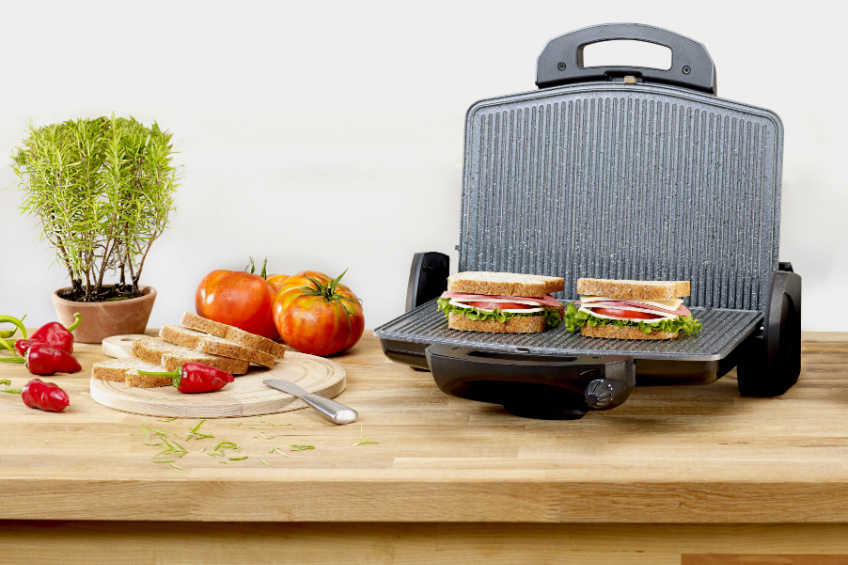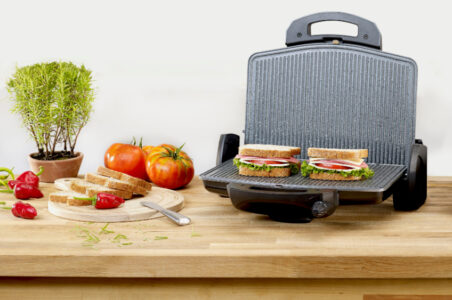 As modern lifestyles continue to evolve, indoor electric barbecue grills are capturing the attention of cooking enthusiasts and casual chefs alike.
As modern lifestyles continue to evolve, indoor electric barbecue grills are capturing the attention of cooking enthusiasts and casual chefs alike.
Their rise in popularity is largely due to convenience and ease of use, allowing people to enjoy grilled flavors without stepping outside.
This shift is especially appealing in urban settings where outdoor space is limited or weather conditions are less predictable.
These grills offer a solution for year-round barbecuing, eliminating concerns about charcoal or propane and reducing smoke.
Their user-friendly design appeals to those looking to simplify meal preparation while enjoying the diverse culinary opportunities that grilling provides.
The growing variety of models now available ensures that there is an indoor electric grill to suit every taste and budget.
As interest in healthy eating gains momentum, these grills also support a trend toward healthier cooking methods.
The ability to grill indoors without added fats is aligning with a broader movement toward nutritious meal choices.
This balance of practicality and health-conscious cooking is a key factor driving their increased use in households.
Evolution of Indoor Electric Barbecue Grills

Indoor electric barbecue grills have undergone significant changes over the years, transforming from basic appliances into sophisticated cooking devices.
Early models focused on simplicity with minimal design features and basic heating elements.
Advancements in Technology:
Recent advancements allowed manufacturers to increase the grilling efficiency of these devices.
Modern grills brought features like temperature controls and non-stick surfaces.
The addition of drip trays and smoke filters made indoor grilling more practical and cleaner.
Design and Portability:
Design improvements enhanced the aesthetic appeal, allowing these grills to fit well in contemporary kitchens.
Portable and compact models have made them appealing for small apartments, broadening their usability.
Gone are the days when grilling was strictly an outdoor affair.
Material and Durability:
Manufacturers now use high-quality materials, such as stainless steel, to ensure longevity.
This shift not only improves the device’s aesthetics but also its resistance to regular wear and tear.
Energy Efficiency:
Over time, energy efficiency has become a priority.
Newer models consume less electricity, aligning with eco-friendly objectives and reducing operating costs.
This change appealed to environmentally-conscious consumers seeking sustainable living options.
These developments reflect the changing preferences and needs of consumers who desire the convenience of barbecuing indoors without compromising on flavor and performance.
Benefits of Indoor Electric Barbecue Grills

Indoor electric barbecue grills offer several advantages that appeal to modern culinary needs.
Their design supports convenient cooking while enhancing health benefits.
These appliances also provide the flexibility to barbecue any time of the year with less smoke and odor concerns.
Convenience and Ease of Use
Indoor electric grills are straightforward to operate, making them an ideal choice for those seeking hassle-free cooking solutions.
There is no need for charcoal or gas, simplifying the setup process.
Users can plug them in for immediate use, eliminating the need for outdoor space or extensive preparation.
The temperature control features on these grills allow for precise cooking.
This control ensures that food is cooked evenly, reducing the risk of undercooked or overdone meals.
Cleaning is also less demanding, with many grills featuring non-stick surfaces and removable parts that are dishwasher safe.
Healthier Cooking Options
Electric grills are designed with health-conscious users in mind.
Many models incorporate a drip tray that collects excess fat and oil.
This feature helps reduce calorie content, offering a healthier alternative to traditional grilling methods.
The grilling surface allows food to be cooked without the need for additional fats or oils.
They promote even cooking, ensuring the retention of nutrients.
The absence of open flames reduces the formation of harmful compounds, making meals cooked on electric grills a healthier option.
Year-Round Barbecue Possibility
These grills enable barbecuing without being subject to weather conditions since they are suitable for indoor use.
This convenience means that grilling isn’t restricted to warm months or dry weather, providing a consistent opportunity for those who enjoy grilled dishes.
Electric grills are compact, making them suitable for a variety of indoor settings.
From apartments to homes with limited outdoor space, these grills fit comfortably, transforming indoor spaces into efficient grilling areas.
This accessibility allows enthusiasts to enjoy barbecued meals throughout all seasons.
Minimal Smoke and Odor
Electric grills produce less smoke compared to traditional charcoal or gas grills.
This reduction is due to their lack of open flames and the controlled heating elements they possess.
This quality makes them suitable for use in enclosed spaces like kitchens, reducing the risk of irritating smoke accumulation.
Odor generation is also minimized, helping maintain a pleasant indoor environment.
This benefit is particularly significant in shared living spaces or for those who are sensitive to strong smells.
Smoke and odor control makes electric grills a practical choice for indoor cooking spaces.
Comparative Analysis with Traditional Grills

Electric grills provide efficient, convenient alternatives to traditional grilling methods.
They offer unique benefits in aspects like usability, cleanliness, and setup which differentiate them from charcoal and gas grills.
Electric vs. Charcoal Grills
Electric grills boast an ease of use that charcoal grills struggle to match.
They require minimal setup and effectively eliminate the mess related to charcoal residue and ash disposal.
Users simply plug them in and commence cooking, making them ideal for indoor use.
Temperature control is precise, allowing for consistent grilling without the need for constant supervision or adjustment.
Charcoal grills, known for their smoky flavor, require more attention to manage heat through airflow and fuel. Lighting the charcoal also demands patience and skill.
Flavors from charcoal cooking may be preferable for some, yet electric grills offer a convenient, smokeless experience.
Safety is enhanced with electric models, as they don’t involve open flames or combustible materials.
Electric vs. Gas Grills
When compared to gas grills, electric grills excel in simplicity and maintenance.
Users of electric grills benefit from the absence of propane tanks, reducing potential hazards and the hassle of refilling.
They feature straightforward controls, enabling easy temperature adjustments for consistent cooking results.
Additionally, electric grills often require less space, making them suitable for confined urban settings or indoor locations.
Gas grills, popular for outdoor cooking, can provide a broader range of cooking temperatures and faster heating.
However, their reliance on gas can make them less eco-friendly.
Furthermore, electric models typically cost less to operate long-term.
Their compact size and efficiency make electric grills an attractive option for those prioritizing convenience and safety in their cooking routines.
Factors Driving Popularity

Indoor electric barbecue grills are becoming increasingly popular due to their suitability for small living spaces, advances in technology, and benefits for the environment.
These factors make them an attractive option for modern consumers seeking convenience and sustainability.
Urban Living and Space Constraints
As urbanization increases, more people live in apartments or condos with limited outdoor space.
Traditional grills can be cumbersome and impractical for these settings. Indoor electric grills fit easily on kitchen counters and don’t require outdoor ventilation.
This convenience is crucial for those with little room to spare.
Compact design and ease of storage make them ideal for those prioritizing space efficiency.
Restrictions on open flames in many urban residential areas further push residents towards electric options.
When it comes to maximizing space without sacrificing grilling opportunities, indoor electric grills meet the demands of urban living effectively.
Technological Advancements
Technological improvements have significantly enhanced the functionality of indoor electric grills.
Features like precise temperature control, non-stick surfaces, and rapid heating elements offer users a convenient cooking experience.
Smart connectivity has also made grilling more accessible, with some models featuring app controls for remote operation.
Innovations in heat distribution technology ensure even cooking, reducing the risk of undercooked food. These advancements offer a level of convenience unmatched by traditional grills.
For tech-savvy users, the ability to customize and monitor cooking through smart devices is a strong attraction.
The integration of these technologies increases user satisfaction and broadens the appeal of electric grills.
Environmental Considerations
Indoor electric grills appeal to eco-conscious consumers who seek more sustainable cooking methods.
Unlike charcoal or gas grills, electric grills produce no harmful emissions, contributing to cleaner indoor air quality.
They require less energy overall, making them a superior choice for reducing carbon footprint.
Since electric grills generate less waste and avoid the use of fossil fuels, they align well with green living practices.
This appeal drives their popularity among those committed to environmentally-friendly lifestyles.
Thus, choosing an indoor electric grill supports not only efficient cooking but also a commitment to the planet’s health.
Usage Scenarios

Indoor electric barbecue grills offer flexibility for various settings where conventional grills aren’t suitable.
Their utility shines through in entertaining guests indoors, catering to small households, and providing solutions during harsh weather conditions.
Indoor Entertainment
Indoor electric grills prove to be a convenient option for social gatherings.
They allow hosts to prepare meals without stepping outside, creating a more seamless experience.
These grills also offer smoke-reducing features, limiting odors and mess, which can be appealing to those hosting events indoors.
Key Benefits:
- Smoke Control: Advanced technology reduces smoke production.
- Ease of Use: Simple operation and easy cleanup.
- Versatility: Capable of grilling various foods, from vegetables to meats.
These characteristics cater directly to the needs of both experienced cooks and beginners looking to entertain efficiently.
Small Households
For small households, electric grills provide a practical solution, fitting well into compact living spaces.
They don’t require much storage room and can be placed on countertops when needed.
This makes them suitable for apartments or studios where outdoor grilling is not an option.
Advantages for Small Households:
- Compact Design: Suitable for limited kitchen spaces.
- Energy Efficiency: Consumes less power compared to larger outdoor grills.
- Quick Heating: Reduces wait time for meal preparation.
These features make them a cost-effective and space-saving choice for individuals or couples.
Inclement Weather Compatibility
Inclement weather can disrupt outdoor grilling plans, yet electric grills eliminate this concern.
By being fully functional indoors, they ensure that rain or snow doesn’t interfere with cooking schedules.
Users can enjoy grilled food year-round, irrespective of weather conditions.
Weather-Resistant Benefits:
- Year-Round Grilling: Overcome limitations posed by weather.
- Consistent Performance: No reliance on external conditions for heating.
- Safety Features: Designed to minimize risks associated with indoor use.
This reliability offers a sense of assurance, making indoor electric grills an appealing alternative for those who enjoy grilling any time.
Selecting the Right Indoor Electric Grill

Choosing the ideal indoor electric grill involves considering its size and portability, assessing temperature control features, and evaluating ease of maintenance and cleaning.
Each aspect influences convenience and performance, guiding informed decision-making.
Size and Portability
When selecting an indoor electric grill, size is a key consideration.
Grills come in various dimensions, catering to different cooking needs and kitchen spaces.
Smaller models are suitable for individuals or small families, making storage and kitchen placement easier.
Portability is essential for those with limited space or who occasionally move their grills.
Look for models with manageable weight, compact designs, and features like foldable legs or carrying handles.
These factors can enhance mobility and ease of use.
Temperature Control Features
Temperature control is crucial for achieving desired cooking results.
Modern indoor electric grills feature adjustable thermostats, allowing precise control over heat settings.
This precision ensures food is cooked evenly without overcooking or burning.
Digital displays and pre-set cooking programs can enhance user experience by simplifying operation.
Such features are useful for busy individuals who need consistent cooking temperatures quickly and efficiently.
A grill with strong temperature control capabilities provides flexibility in cooking a range of foods.
Maintenance and Cleaning
Regular maintenance and easy cleaning extend the grill’s lifespan and ensure optimal performance.
Many grills have non-stick surfaces that prevent food from adhering, simplifying the cleaning process.
Removable parts, like drip trays and grates, also contribute to convenience.
These elements should be dishwasher safe, reducing cleaning time and effort.
Consider grills with minimal crevices or complex parts, as these areas tend to collect residues requiring more detailed cleaning.
Types of Electric Grills

There are generally two types of electric grills based on their design and cooking style: open grill style and contact grill style.
Open Grill Style
Open grill style electric grills resemble traditional outdoor grills, with an open grilling surface where the food is placed directly on the grates.
The heat is typically provided by electric heating elements located below the grates, and the food is cooked by direct exposure to the heat.
Open grill style electric grills are suitable for grilling larger cuts of meat, whole fish, or vegetables, and they allow for distinct grill marks on the food.
This type of indoor grill comes with a lid and gives you more grilling options while keeping the smoke and steam contained.
 The Weber Q2400 is a compact, open grill-style electric grill that offers excellent performance for outdoor grilling without the need for gas or charcoal.
The Weber Q2400 is a compact, open grill-style electric grill that offers excellent performance for outdoor grilling without the need for gas or charcoal.
This electric grill is a great option for people who live in apartments or places where traditional grilling might not be allowed due to fire hazards or regulations.
A great option for anyone who loves open grilling but prefers the simplicity, convenience, and safety of an electric-powered device.
Contact Grill Style
Contact grill style electric grills have a hinged top and bottom plate that come into direct contact with the food, similar to a panini press.
The heat is provided by electric heating elements in both the top and bottom plates, which cook the food from both sides simultaneously.
Contact grill style electric grills are ideal for cooking thinner cuts of meat, sandwiches, and other foods that require even cooking on both sides.
They are also known as “Panini press” or “Panini grills” due to their popularity in making grilled sandwiches.
This grill is good at cooking steaks, fillets, vegetables and they are flexible and can be detached easily making it easy to wash them by hand or in the dishwasher.
The George Foreman 5-Serving Multi-Plate Evolve Grill is a versatile, contact-style electric grill that is designed to offer convenience and high performance for both grilling and cooking indoors.
A versatile, easy-to-use contact-style electric grill that offers multiple cooking options.
It’s an excellent choice for people who want to enjoy grilled meals indoors with a compact design and the convenience of quick, easy cooking and clean-up.
Both open grill style and contact grill style electric grills have their advantages and are suitable for different cooking needs.
Open grill style is great for larger cuts of meat or when you want distinct grill marks, while contact grill style is ideal for thinner cuts of meat and sandwiches.
Consider your cooking preferences and needs when choosing between the two types of electric grills.
Consumer Behavior and Market Trends

Consumers are increasingly interested in convenient and healthier cooking options, driving the demand for indoor electric barbecue grills.
These grills offer a smoke-free and quick alternative to traditional outdoor grilling, appealing to urban dwellers.
Market research indicates a growing segment favoring compact appliances for smaller living spaces.
Electric grills fulfill these needs by being space-efficient and easy to store.
This trend aligns with the rise in apartment living, where outdoor grilling is often restricted.
Key Features Consumers Look For:
- Portability: Lightweight designs for easy movement.
- Ease of Use: Simple controls with quick setup.
- Healthier Cooking: Fat-draining features and non-stick surfaces.
Recent market trends show a notable increase in sales during colder months.
This suggests that consumers seek grilling options year-round, regardless of weather conditions.
Electric grills, with their all-weather capability, fit this requirement perfectly.
E-commerce platforms report a significant increase in online searches and purchases for electric grills.
This could be attributed to the convenience of online shopping and the detailed product information available, allowing consumers to make informed decisions.
Brands are responding by offering diversified product lines with varying sizes, features, and price points.
This strategic diversification helps attract a broader consumer base, catering to different preferences and budgets.
Overall, these trends and behaviors demonstrate a shift towards more adaptable, indoor-friendly, and easy-to-use grilling solutions, reflecting changing lifestyles and preferences.
Safety Precautions and Guidelines

When using indoor electric barbecue grills, users should always prioritize safety.
Ensure the grill is placed on a stable, heat-resistant surface.
This prevents tipping or damage to countertops.
Proper Ventilation:
Good airflow is essential. Use the grill in well-ventilated areas to reduce smoke accumulation.
Opening windows or using fans can help.
Avoid Water:
Keep water away from the grill to prevent electrical hazards.
Make sure hands are dry when handling electrical components.
Use Correct Power Sources:
Plug the grill into appropriate outlets, avoiding use of extension cords.
This helps manage the power load safely.
Regular Cleaning:
Clean the grill after each use. Fat and food particles left behind can cause smoke and unpleasant odors.
- Before Cleaning: Ensure the grill is unplugged and cooled down.
- Cleaning Tools: Use non-abrasive sponges and mild detergents.
Monitoring Cooking:
Never leave the grill unattended while in use.
Children and pets should be kept at a safe distance to avoid accidental contact or burns.
Follow Manufacturer Instructions:
Each model may have specific guidelines.
Adhering to these ensures optimal device operation and longevity.
Emergency Preparedness:
Keep a fire extinguisher nearby and know how to use it.
Familiarize yourself with basic fire safety procedures just in case.
For added protection, manufacturers may include auto-off features or overheat protection.
These can offer peace of mind and enhance safety during use.
By carefully observing these safety measures, users can enjoy their indoor grilling experience with reduced risk.
Future Outlook on Indoor Electric Grilling

The market for indoor electric grills is expected to continue growing steadily.
With urban living spaces becoming more compact, these grills offer a practical cooking solution.
Their compact size fits well in smaller kitchens, making them a popular choice for apartment dwellers.
Technological advancements are enhancing grill features.
Many new models now incorporate smart technology, such as app connectivity and adjustable temperature controls, providing users with greater flexibility and precision in cooking.
Environmental considerations are increasingly important.
Indoor electric grills have a lower environmental impact compared to traditional charcoal or gas grills, making them appealing to environmentally-conscious consumers.
They produce fewer emissions and use less energy, aligning with the shift towards more sustainable living.
The versatility of these grills attracts a wide range of users.
From grilling meats to roasting vegetables and making sandwiches, their multifunctionality caters to various dietary preferences and needs, thereby expanding their appeal across diverse demographics.
Electronics companies are investing in innovation.
Brands are focusing on improving heat distribution and enhancing non-stick surfaces, ensuring easier cleanup and improving user experience.
This investment in R&D suggests a promising future for indoor electric grills.
In summary, several factors–compact design, technological improvements, environmental benefits, versatility, and industry innovation–point towards a positive trajectory for indoor electric barbecuing.

